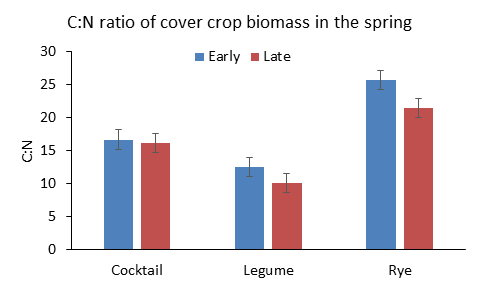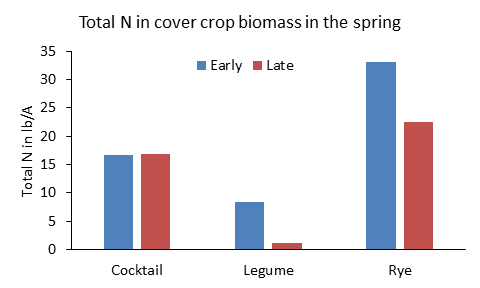By Natalie Holste, Missouri University of Science and Technology biological sciences student and 2016 University of Nebraska Experiential Fellow
Cover crops grown after primary crops can reduce costly nitrogen (N) losses by taking up soil N into their biomass. After these cover crops are killed, soil microorganisms decompose their residue, using their carbon as an energy source and their N to build protein. A carbon-to-N (C:N) ratio of 24:1 is best for soil microbes. At higher C:N ratios, such as in later growth stages of cereal crops, microbes will take N from the soil for their growth. This lowers the soil N available to crops. At lower C:N ratios, like those found in legumes, microbes will release (mineralize) N, making it available for crops.
In our study, we wanted to investigate whether the species and age of the cover crop affected the C:N ratio, percent N and total N in the aboveground biomass of cover crops. This research was part of an ongoing cover crop research project funded by the Nebraska Corn Board and Nebraska Soybean Board.
For this study, cover crops (cereal rye, legumes and a cocktail mix) were grown at the UNL Agricultural Research and Development Center near Mead. They were planted either early (early September) or late (mid-October after crop harvest). Aboveground cover crop biomass was sampled in mid-April when cover crops were terminated. Cover crop biomass was dried, weighed and analyzed for percentage of carbon and N. To find the total N content of the cover crop biomass, the percentage of N was multiplied by the amount of biomass (dry weight).
Results
 Figure 1. Carbon-to-nitrogen (C:N) ratio of early- and late-planted cover crop biomass in the spring.
Figure 1. Carbon-to-nitrogen (C:N) ratio of early- and late-planted cover crop biomass in the spring.
Cover crop C:N ratio was higher for cover crops that were planted early and contained rye (Figure 1). Cover crop C:N ranged from 25:1 for the early-planted rye to 10:1 for the late-planted legume. The amount of total N (in pounds per acre) is the product of the percent of N and biomass (in pounds per acre) (Figure 2).
The percent N of the legume biomass was 3.7%, 2.7% for the cocktail mix and 1.9% for the rye. Legumes produced the least amount of biomass (300 pounds per acre for the early planting and 30 pounds per acre for the late planting) and rye produced the highest biomass (2,100 pounds per acre for the early planting and 1,100 pounds per acre for the late planting). Total N was highest for rye (33 pounds per acre for the early planting and 23 pounds per acre for the late planting) and lowest for the legume (8 pounds per acre for the early planting, 1 pound per acre for the late planting). Total N was intermediate for the cocktail mix since it produced only about half the amount of biomass that rye did.
Conclusions
 Figure 2. Total nitrogen in various cover crops planted early and late as measured in the spring.
Figure 2. Total nitrogen in various cover crops planted early and late as measured in the spring.
The results of this study showed that legumes supplied little total N because their biomass production was very low. In contrast, rye residue contained a much higher amount of total N because of its high biomass production. Rye took up soil N left by the previous crops, possibly preventing N leaching. The cover crop C:N ratio increases with plant age and was highest for early planted rye. However, it was within the optimum range for C:N ratio, so N immobilization is unlikely to occur. This means the N contained in the rye residue will likely be readily available to the subsequent corn. This study shows that to ensure a N supply, cover crop dry matter must be high. To avoid N immobilization, cover crops should be terminated before their C:N ratio is greater than 24:1, probably in mid to late April for rye cover crops.





